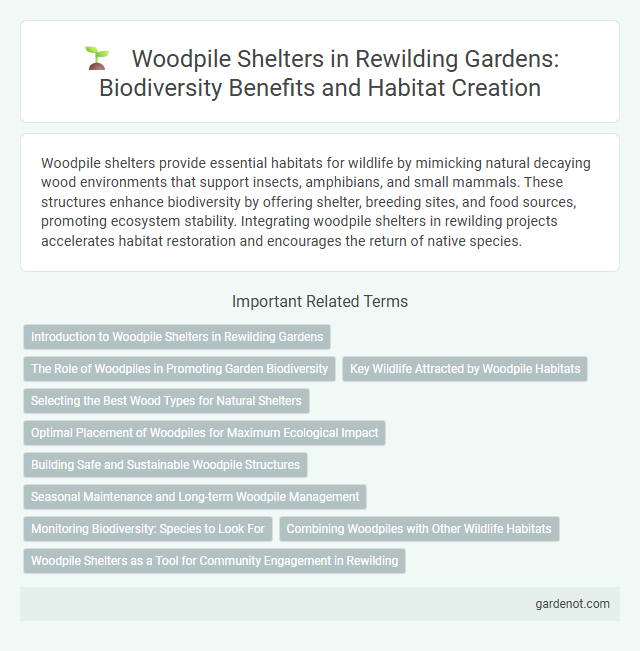Woodpile shelters provide essential habitats for wildlife by mimicking natural decaying wood environments that support insects, amphibians, and small mammals. These structures enhance biodiversity by offering shelter, breeding sites, and food sources, promoting ecosystem stability. Integrating woodpile shelters in rewilding projects accelerates habitat restoration and encourages the return of native species.
Introduction to Woodpile Shelters in Rewilding Gardens
Woodpile shelters in rewilding gardens serve as vital habitats for various wildlife, promoting biodiversity by providing refuge and nesting sites for insects, amphibians, and small mammals. Constructed from stacked logs and branches, these structures mimic natural woodland debris, enhancing ecosystem complexity and supporting native species regeneration. Incorporating woodpile shelters encourages sustainable garden practices by fostering a balanced, self-sustaining environment.
The Role of Woodpiles in Promoting Garden Biodiversity
Woodpile shelters provide essential habitats for insects, amphibians, and small mammals, significantly enhancing garden biodiversity by creating micro-ecosystems that support various species. These structures offer shelter, breeding grounds, and food sources, promoting natural pest control and soil health through increased decomposer activity. Incorporating woodpile shelters in rewilding efforts boosts ecosystem resilience, fostering balanced and thriving gardens.
Key Wildlife Attracted by Woodpile Habitats
Woodpile shelters create essential habitats that attract a diverse range of wildlife, including small mammals like hedgehogs and voles, as well as reptiles such as slow worms and common lizards. These structures provide crucial shelter and breeding grounds for invertebrates like beetles and spiders, which play a vital role in ecosystem health. Birds including wrens and robins also benefit from these microhabitats, finding food and protection within the woodpile's layered environment.
Selecting the Best Wood Types for Natural Shelters
Choosing the right wood types for woodpile shelters significantly impacts durability and insulation. Hardwoods like oak, hickory, and maple offer exceptional resistance to moisture and pests, ensuring long-lasting structural integrity. Softwoods such as cedar and pine are preferred for their natural insect-repellent properties and ease of stacking, making them ideal for eco-friendly, natural shelter construction in rewilding projects.
Optimal Placement of Woodpiles for Maximum Ecological Impact
Optimal placement of woodpiles involves positioning them in shaded, moist areas near existing wildlife corridors to foster biodiversity and habitat connectivity. Woodpiles placed along forest edges or near streams provide essential shelter and breeding sites for insects, amphibians, and small mammals, enhancing ecosystem resilience. Strategic distribution across various microhabitats maximizes ecological benefits, promoting nutrient cycling and supporting complex food webs.
Building Safe and Sustainable Woodpile Structures
Building safe and sustainable woodpile shelters requires selecting durable, rot-resistant wood such as cedar or oak to ensure long-lasting structural integrity. Proper stacking techniques, including tight interlocking and balanced layers, maximize stability and prevent collapse during adverse weather conditions. Incorporating natural insulation materials like moss or leaves within the stacks enhances thermal regulation while maintaining ecological harmony in rewilding environments.
Seasonal Maintenance and Long-term Woodpile Management
Woodpile shelters require seasonal maintenance to protect stacked logs from moisture, pests, and fungal decay, ensuring optimal dryness and usability for wildlife habitats. Regular inspection for rot and rearrangement of logs promotes airflow and prolongs the woodpile's structural integrity, essential for supporting biodiversity over multiple seasons. Long-term woodpile management includes replenishing decayed wood, monitoring insect activity, and adjusting the shelter's location to adapt to environmental changes and sustain ecosystem health.
Monitoring Biodiversity: Species to Look For
Woodpile shelters create vital habitats supporting a diverse range of species including amphibians like salamanders, insects such as beetles and spiders, and small mammals like shrews and mice. Monitoring biodiversity around these shelters involves tracking the presence of indicator species that signify ecosystem health, such as amphibians sensitive to environmental changes and wood-dependent beetles. Regular surveys focusing on these key species offer valuable data for assessing the success of rewilding efforts and habitat restoration.
Combining Woodpiles with Other Wildlife Habitats
Integrating woodpile shelters with diverse wildlife habitats enhances biodiversity by providing essential resources such as nesting sites, hunting grounds, and shelter for various species including insects, amphibians, and small mammals. Positioning woodpiles near hedgerows, ponds, and wildflower meadows creates ecological corridors that support species movement and genetic exchange. This habitat mosaic fosters resilient ecosystems by promoting complex food webs and improving soil health through increased organic matter and microbial activity.
Woodpile Shelters as a Tool for Community Engagement in Rewilding
Woodpile shelters serve as vital habitats supporting biodiversity by providing shelter for insects, small mammals, and birds, which enhances local ecosystems in rewilding projects. These structures foster community engagement by involving local volunteers in their construction and maintenance, creating hands-on opportunities to connect with nature and learn about native species. Integrating woodpile shelters into rewilding initiatives strengthens ecological resilience while promoting environmental stewardship and education within the community.
Woodpile shelter Infographic

 gardenot.com
gardenot.com